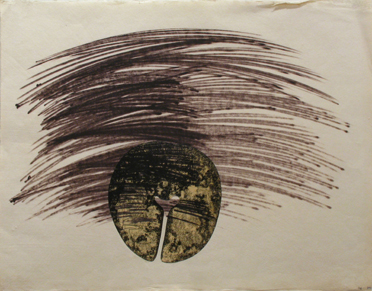Good Vibrations as the Michener Opens Harry Bertoia Exhibition in Doylestown


THE SOUND OF AIR AND STEEL: Harry Bertoia (1915-1978), Untitled, c. 1970s, Ink on paper, 22 x 27 inches from the collection of Celia Bertoia is part of the exhibition “Harry Bertoia: Structure and Sound,” through October 13 at the Michener Art Museum, 138 South Pine St., Doylestown, Pa. For admission and hours, call (215) 340-9800 or visit: www.michenerartmuseum.org.
“Structure and Sound,” an exhibition of sculpture, furniture, monoprints, and jewelry by the Italian-born artist Harry Bertoia, opened Saturday, July 20 in the Beans Gallery at the James A. Michener Art Museum in Doylestown.
Described as a man ahead of his time, Bertoia (1915-1978) experimented with space and sound. A longtime resident of Bally, Pennsylvania, he created his well-known sonambient or tonal sounding sculptures and designed furniture for Knoll, Inc. there.
Born in 1915 in San Lorenzo, Italy, Bertoia came to the United States at the age of 15 to visit his older brother. He learned art, design, and jewelry making in high school and at the Art School of the Detroit Society of Arts and Crafts, now the College for Creative Studies.
In 1937 he received a scholarship to study at the Cranbrook Academy of Art where he encountered the work of Walter Gropius, Edmund N. Bacon, and Ray and Charles Eames whose wedding rings he designed and made.
In 1943, when he married Brigitta Valentiner, the couple moved to California to work for Charles and Ray Eames.
His early studies in printmaking and metalwork at the Cranbrook Academy of Art informed the work of his later career. Drawing was an important part of the artist’s creative process, and many of his compositions articulate his planning and experimentation for sculpture.
In 1950, at the invitation of the Knoll furniture design company, he moved to eastern Pennsylvania and designed, among other pieces, the Bertoia Diamond Chair series, a series of wireframe chairs that became an iconic part of the modern furniture movement. His famous “Diamond Chair’ is a fluid, sculptural form made from a molded lattice work of welded steel. He described the chairs as being “mainly made of air, like sculpture. Space passes right through them.”
Made by hand and produced with varying amounts of upholstery over their light grid-work, the chairs were an immediate commercial success and are still sold by Knoll today. Bertoia’s earnings from them allowed him to devote himself exclusively to sculpture and to explore the ways in which metal could be manipulated to produce sound. By stretching and bending the metal, he made it respond to wind or to touch, creating different tones.
The Tonal
The sculpture most associated with Bertoia is “The Tonal.” Varying in size from a few inches up to 19 feet and made of steel, copper, and brass rods capped with cylinders or drops of metal, Bertoia’s sculptures swayed, emitting sounds according to the weight and materials of their composition.
He performed with his pieces, manipulating his artwork manually, in a number of concerts and produced a series of ten albums, all entitled Sonambient.
The artist’s Pennsylvania home and studio included a barn space installation of 75 tonals of varying heights and is maintained today by his son, Val Bertoia, who is also an artist. Occasional symphonic musical performances are held there. Album recordings made by Harry Bertoia are included in the Michener installation.
Besides tonal and static sculptures by Bertoia, the exhibition also features work from his explorations into jewelry making, crafting organic forms of silver and copper, as well as monoprints and furniture. It is made up of selections from private collections, as well as from the Reading Public Museum, Knoll, Inc., the Woodmere Art Museum, and the Philip and Muriel Berman Museum of Art at Ursinus College.
Bertoia is known not only for his signature 1952 Diamond Chair but also for his work with a number of major 20th century architects: Eero Saarinen, Henry Dreyfuss, Roche & Dinkeloo, Minoru Yamasaki, Edward Durell Stone, I. M. Pei and others. In 1956, he received the AIA Craftsmanship Award, followed by the Critic’s Award in 1968.
His work is held in numerous public collections including the Brooklyn Museum, the Philadelphia Museum of Art, the Smithsonian American Art Museum, and museums in Cleveland, Dallas, Detroit, and Washington, D.C.
To coincide with the exhibition, independent scholar Mary Thorp, who has been cataloguing Bertoia’s sculptures, organizing exhibitions, and lecturing on his work at auction houses, museums and universities since 1998, will give an overview of the artist’s work on Tuesday, September 17, from 1 to 3 p.m. The artist’s daughter, Celia Bertoia, who is currently at work on a biography of her father, will discuss his techniques and share behind-the-scenes stories on Friday, October 4, from 2 to 3 p.m.
“Harry Bertoia: Structure and Sound,” continues through October 13 at the Michener Art Museum, 138 South Pine St., Doylestown, Pa. For admission and hours, call (215) 340-9800 or visit: www.michenerartmuseum.org.

